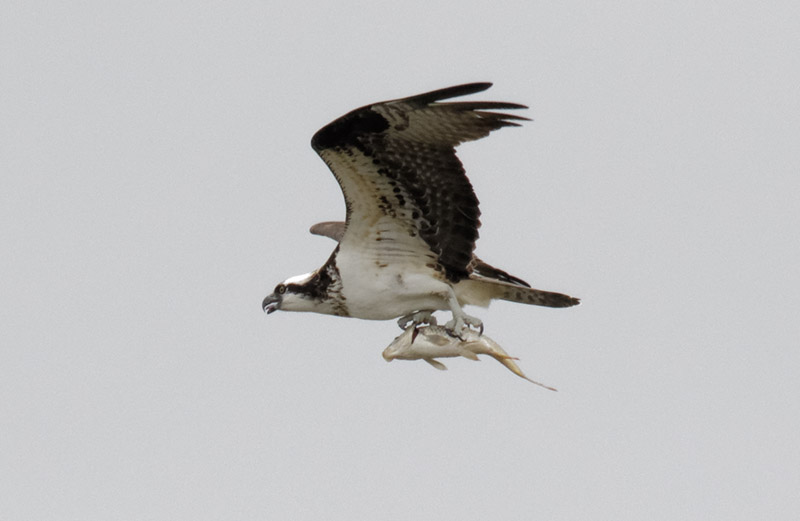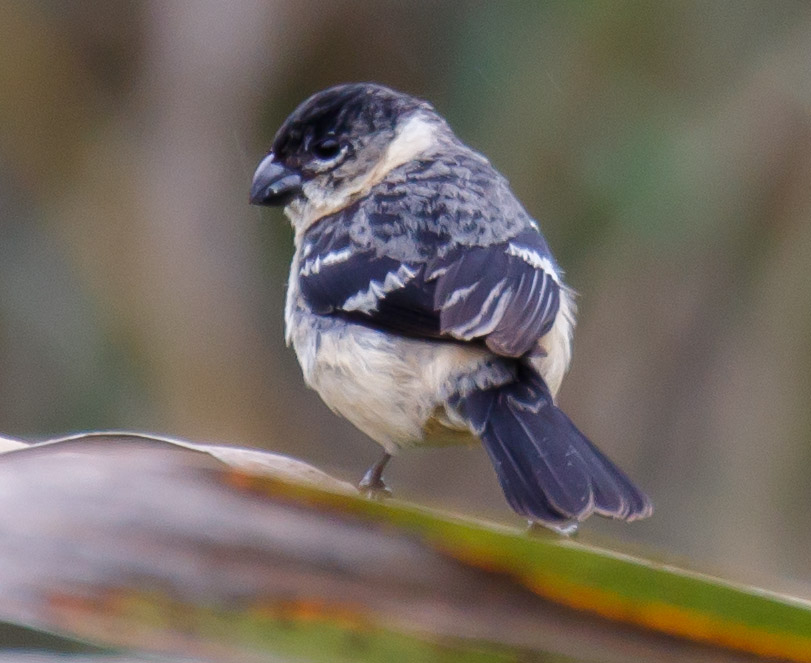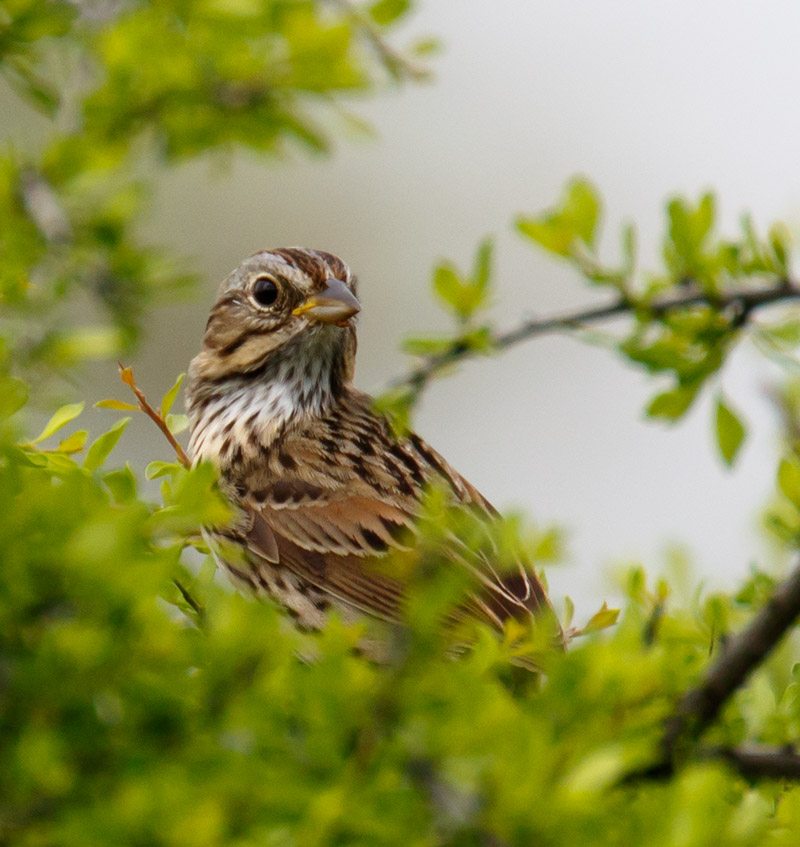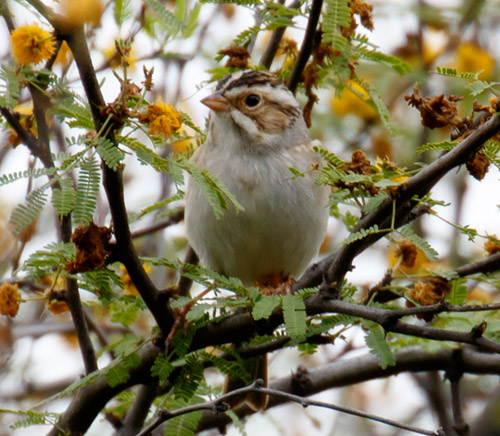
Texas Sparrow Quest
April 15-16, 2015
As we left the lower Rio Grande Valley after a final stop at Anzulduas for more warblers, we followed the advice of Keith Hackland at the Alamo Inn and made our first stop at Salineño, Texas, just north of Roma. We drove straight down to the Rio Grande. We were searching for Red-billed Pigeon and orioles.
 The logs in the river had a few different turtles, a Spotted Sandpiper, and a few active Osprey along the river that caught Mike's eye, as they were close and fishing. We traipsed along the trail to the NW until it ended, allowing us closer looks at the Osprey who was hanging out with a half-eaten fish. Despite the gloomy light and light drizzle, Mike managed to get a few nice shots of the bird flying with his fish.
The logs in the river had a few different turtles, a Spotted Sandpiper, and a few active Osprey along the river that caught Mike's eye, as they were close and fishing. We traipsed along the trail to the NW until it ended, allowing us closer looks at the Osprey who was hanging out with a half-eaten fish. Despite the gloomy light and light drizzle, Mike managed to get a few nice shots of the bird flying with his fish.
Returning along the path, we heard a sparrow chip and could see a pretty large sparrow with an olive wash on his back tucked back in a tangle of dead branches. Sure enough, we managed to find a lovely Olive Sparrow, always a delight, and enjoyed several minutes of good looks and listening to his melodic song.
Keith had suggested that we take Old Church Road to the left as we left town, which would have put us on a dirt road known locally as "Dump Road," and would have deposited us on FM 2098. We quickly abandoned that plan when we encountered a large mucky puddle across the road; the lower path along the river had been slippery enough, and even the possibility of Bobwhites, quail, sparrows and wrens was not enough incentive to risk getting our small rental car stuck in the sticky substrates.
We returned briefly to 83, and the quickly headed NW on FM 2098. At the 4-way stop, we turned left and the quickly right into the Falcon State Park. We were seeking Red-billed Pigeons. We could hear sparrow-like calls from down in the grasses, so we drove in a ways and pulled over to see what we could. Mike caught a quick view of a Greater Roadrunner with a snake in its mouth!
But mostly we ended up having a delightful time with Vermillion Flycatchers and Eastern Phoebe. Although there were a few sparrows flying back and forth in the grasses, they were too skulky to see and I was too freaked out about adding to the chigger infestation on my legs to venture in, even with my fancy insect-repelling socks and pants (which I chose to wear after I discovered the chiggers).
But who can resist the charms of the brilliant red flycatcher, especially when the light is dark and gloomy? (Well, Mike would disagree that the gloomy light is great for photography, but those of us who don't bird from behind a camera enjoy those stark contrasts.) I kept seeing dark doves flying overhead, but couldn't get anything on them, and they always landed far away. After our fun with flycatchers, we decided to head towards a brushy hedgerow of mixed layers, hoping that might produce the pigeon, as we had read that they prefer to stay in the trees above understory brushy stuff. The hedgerow produced nothing beyond the usual suspects (grackles, mockingbirds and Golden-fronted Woodpeckers), but just as we turned back into the grassy picnic/camping area, we once again saw dark doves, and -- voila! -- managed to get our glasses on one perfectly splendid Red-billed Pigeon for about half a minute before he fled. Subsequent looks at the other trees we thought we'd seen the birds fly into turned up nothing. But at least we'd enjoyed the look we had!
We headed on to Zapata, where we decided to give quick tries to two places on the "Official Birding & Butterfly Map of the Rio Grande Valley" before moving on to the wilder spot further north. First was the Seedeater B&B, which seemed closed, at least for now. The yard was busy with House Finch, House Sparrow, and grackles. Mike got another Vermilion Flycatcher at the library, but I was worried about running out of daylight before getting to the renowned San Ygnacio Seedeater Preserve, so we headed out quickly and accessed the preserve via Washington Street and parked in front of an abandoned house (as instructed by Keith, which was a better strategy than following the directions on the map, which encourage parking a few blocks away at the park--likely a great option when the preserve is busy with birders to limit impact on the neighborhood).
We walked down the hill and heard singing right away. Our goal was seedeater and more pigeons, but we once again had amazing views of several singing Olive Sparrows in the area; Mike recalls that we'd only seen this lovely big sparrow once before, with a dark view late in the day at Bentsen on a previous trip to Texas. So what a special treat to be surrounded by them, singing and virtually begging us to pay attention to their loveliness!
As we enjoyed the sparrows, we were frankly annoyed by the large numbers of grackles preventing us from hearing anything else! But patience paid off. Suddenly, we saw a burst of bright yellow, which could only be a Yellow-breasted Chat! Indeed, several chats were hanging out, and just like the sparrows, inviting us to look and enjoy. (My first chat was in a jelly jar at a feeding station in SE Arizona, and I commented at the time how disappointing that I was finally seeing a bird I'd been hankering to encounter for years, but seeing it in that particular way diminished the experience. Subsequently, I had great views in Costa Rica, but again, with the abundance of colorful fauna there, the chat wasn't as a big a deal. So this encounter with two special birds that--for me at least--have been hard to find, was a treat indeed.)
A pair of Black-crested Titmouse also came into the area, and were harassed and chased by a male Red-winged Blackbird that must have had a nest in the area. These little birds are so charming and pretty, we enjoyed watching and listening to their calls as they roamed the area.
 I was starting to get concerned about getting to Del Rio before dark and the large thunderstorms headed our way and had given up hope of seeing either of our target species. Feeling pretty content with the great birds we'd been seeing, I suggested we go, and then turned and saw a male White-collared Seedeater about three meters away on the cane hanging over the pathway! He hung out long enough for Mike to snap a few shots quickly, and then he was gone. We waited a long time and tried pishing him out, all to no avail.
I was starting to get concerned about getting to Del Rio before dark and the large thunderstorms headed our way and had given up hope of seeing either of our target species. Feeling pretty content with the great birds we'd been seeing, I suggested we go, and then turned and saw a male White-collared Seedeater about three meters away on the cane hanging over the pathway! He hung out long enough for Mike to snap a few shots quickly, and then he was gone. We waited a long time and tried pishing him out, all to no avail.
We headed back to the main path, and I was ready to walk up the hill, but Mike disappeared in the opposite direction, toward the river. Frustrated not to be getting on the road as it was drizzling again, I started scanning the trees for something besides blackbirds and grackles. In a small leafless tree, about five meters off the ground, I saw yet another seedeater! This time it was a first-year male, singing away! After watching for a few minutes, it finally occurred to me that my fabulous new scope was sitting there unused, and I was able to get even better views within a few seconds. The bird was so close that the scope was almost too powerful, and I had to back off the zoom. Darn it! Where was Mike? He finally came back around the bend, and I was able to gesture to him so he could try for some photos of the bird. He got a few distant shots before moving closer, which sent the bird into the distance.
We departed, happy with our surprise views of special birds, and a few lifers on the list, too!
As we left town, Mike suddenly stopped the car and gestured towards a flurry of orange on the ground. What was going on? It looked like two male Orioles were fighting, but Mike shared that he had just been reading about this behavior with other species. One of the birds was already dead, on the ground, and the other was instinctually driven to attack, even though it was dead. (And maybe this same male had killed the dead one earlier -- who's to say?) Our presence sent the living bird scurrying before we could get video of this incredible display.
We saw a few more treats on the way out of town, prompting Mike to comment that we'd need to return to this birdy little burg!
The next day, following thunderstorms the previous night and early morning, we headed over to San Pedro Flats Campground in the Amistad National Recreation Area. I had seen this spot recommended birding books, but Mike had his doubts, as there was no info on ebird for this site. Driving in, I started to have doubts, as well, and Mike was already cranky with me for taking too long to figure out my organic produce needs for the next few days in Big Bend with the limited options in Del Rio.
 But we rolled down the windows -- and wow! -- was it birdy sounding! We parked and hung out for a bit, trying to suss out what we might be hearing with our terrible ear-birding skills. We quickly found some little ground-loving sparrows skulking about in the brush piles, and got decent looks at Lincoln's Sparrow that left no doubt what we were seeing and hearing. (Don't you love it when you can figure out what the sparrow actually is?)
But we rolled down the windows -- and wow! -- was it birdy sounding! We parked and hung out for a bit, trying to suss out what we might be hearing with our terrible ear-birding skills. We quickly found some little ground-loving sparrows skulking about in the brush piles, and got decent looks at Lincoln's Sparrow that left no doubt what we were seeing and hearing. (Don't you love it when you can figure out what the sparrow actually is?)
I started to notice a lot of activity in the vegetation that was blooming throughout the area, and we got good looks at both Bell's Vireo and Gray Vireo, though the light was suddenly very dark. I had a particularly great time enjoying the Gray foraging, wishing that Mike were either with me or that I had any skill with a camera.
 The trees were filled with some little sparrow that was hard to see through the thick vegetation, but I finally got enough views to see that we had lots of Clay-colored Sparrows in the trees. These little birds are very subtle in their beauty; one has to appreciate the different shades of brown and gray and the strong facial markings with white eyebrow and moustachial stripes. Most fun of all is watching them sing: only little insect-like buzzes come out of their bills--such a different sound for a sparrow.
The trees were filled with some little sparrow that was hard to see through the thick vegetation, but I finally got enough views to see that we had lots of Clay-colored Sparrows in the trees. These little birds are very subtle in their beauty; one has to appreciate the different shades of brown and gray and the strong facial markings with white eyebrow and moustachial stripes. Most fun of all is watching them sing: only little insect-like buzzes come out of their bills--such a different sound for a sparrow.
We spent quite a lot of time enjoying these fun sparrows, with the occasional addition of more of the vireos popping in; some beautiful Pyrrhuloxia in and out of the area, their bright red crests ruffling in the wind; Ash-throated Flycatcher--the third of the possible Myarchus flycatchers we could see on this journey--working the canopies and flycatching from mid-level snags, thus offering lovely views of its behavior; Bewick's Wren, both on the ground near the sparrows and working its way up tree trunks like a creeper; flocks of Bushtits moving in and out of the canopies and thickets; and White-crowned Sparrows bouncing in and out of the tangles. The subspecies here seemed much larger than the one we're used to at home in Olympia.
Though it was still birdy in this area, we needed to move north and still planned a quick stop up the way at Seminole Canyon State Park. The Park was right off the highway, so an easy stop on our way to Big Bend.
We were barely in the area when we saw sparrow-like birds flying along the creosote bush, desert-scrub habitat. We quickly stopped and tried to get on the birds: Lark Buntings--another lifer for both of us! The males were in their early spring plumage, and though they were moving around quite a bit and weren't close to the road, we were ultimately able to get decent views in the scope and a few photos of both males and females.
While trying to get on the buntings, we saw several other sparrows: Lark Sparrow, White-crowned Sparrow, Black-throated Sparrow, Rufous-crowned Sparrow--each gloriously beautiful and interesting sparrows in their own right. What an overwhelming treat--especially for a self-confessed sparrow nerd as me--to see them all in the same area!
In the midst of all this excitement, we were attracted to an insistent song from some small bird on the other side of the road. It was clearly right there. But what was it? We tried approaching stealthily, and it continued singing, even though we were sure it knew we were there. We circled the bush. More singing. We walked around and around. No luck. Finally, it flew up about six feet in the air in a quick fly-catching move, and then just as quickly back into a hiding space down low. More singing. I found myself again in this stereotypical insanely obsessive birder mode, convinced that I could just wait the bird out and eventually figure it out. So often in my experience as a middling birder, this just doesn't ever pay off, as the bird skulks off and leaves me staring at the bush for hours after its gone. But in this case, the fellow was singing away, so if he was willing, so was I. Finally, he flew up again in fly-catching mode and crossed the road, landing in plain sight down low! He continued his up and down fly-catching from here, so I could finally follow him and get my glasses on him. A Cassin's Sparrow! A long-quested bird on my quest to see all the sparrows! I was even able to finally scope him and enjoy watching him deliver his lovely, complicated song, and his simple but beautiful plumage.
I should mention that right after we had pulled in and stopped, a nice older couple stopped nearby and chatted with us briefly. I wasn't as friendly as I would have liked to be, as I was on a sparrow quest and had no time for chit-chat! But later we met them again in Big Bend, and enjoyed a delightful conversation with Orville and Helen from Kansas City, MO.
It was the first sun that we had on this birding trip, as we'd had clouds and heavy rain further east, and we managed to get a bit sunburned. Mike had been dutifully applying sunscreen every morning on this trip...until today. Ooops.
Though we hated to leave this area after not even making it past the entry road to the park, we had a lot of driving still to do and really wanted to enter Big Bend during daylight hours. The rest of the day was spent enjoying the glorious scenery on the way to Big Bend, with some hawks, ravens, interesting geology, and one of the most stunning wildflower displays I've seen in years. Lucky us to have serendipitously timed our visit with the year of the rains, which produced some of the most widespread and diverse "super blooms" since before the drought hit years ago. We managed to make it to the park entrance and pay our fee with 20 minutes to spare before closing, allowing us plenty of daylight to enjoy yet more amazing flowers as we drove SW through the park, get some exercise walking the remote areas near our motel, and seeing a few birds, such as Cactus Wren, Lesser Goldfinch, and the usual assortment of mockingbirds and House Sparrows found around human habitation.
